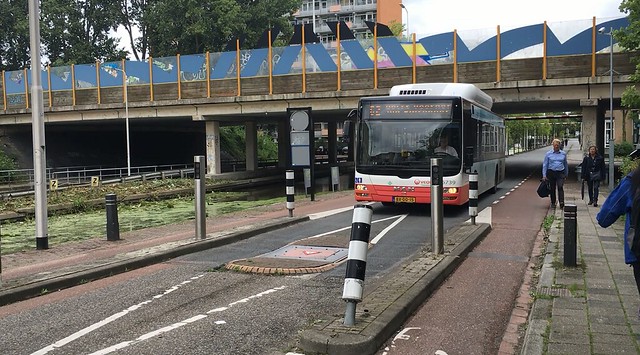Systematic Safety – Permeable Barriers
Peter Kelly & Anthony Green
a) The main objective of permeable barriers is to prevent drivers from using local streets as through streets. Sometimes, a local street can present a more attractive route to a destination than the intended route traveling on connector/distribution roads. In these situations Dutch traffic engineers will place permeable barriers at key points on local streets so that any possible through traffic is removed from the street.
Map
Photo
b) According to Dutch traffic concepts, a road should only have one function. Buitenwatersloot’s intended use is a local street for residents that live on it or on one of the side streets such as Oliemolen or Marlotlaan. But Buitenwatersloot presents a potentially attractive east-west route through Delft, so traffic engineers implemented these barriers to remove any possibility of through traffic from the roadway. The treatment ensures that Buitenwatersloot functions as intended – as a local street.
c) To the west of the permeable barrier, Buitenwatersloot connects with a few residential neighborhoods such as those on Schoolstraat, Oliemolen, and Marlotlaan. To the east, there is a sizable apartment complex framed by Buitenwatersloot and Coenderstraat.
d) Permeable barriers are an effective treatment for this site. Since no through traffic is allowed, the only cars that we observed driving on the street were cars driving to local neighborhoods. The result was a street with barely any car traffic, leaving a great space for pedestrians and cyclists.
e) The treatment is self-explanatory. There is a do-not-enter (except bikes) sign as well as a sign letting drivers no if they enter the site, there is a camera watching and they will be fined. We observed a driver trying to use the route as a through route, but upon approach on the permeable barrier site, the driver turned around and drove back the way he/she came.
f) There used to be a bollard that rose up in the middle of the barrier, and buses had a chip that would lower the bollard upon approach. But the Dutch found this to be unnecessary since the signage and threat of fine is enough to keep drivers from traversing the barrier. So, as it stands now, this barrier is actually permeable to cars.


